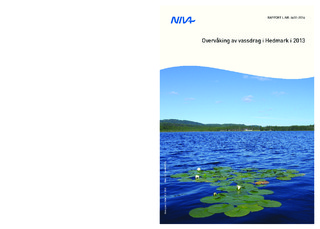Overvåking av vassdrag i Hedmark i 2013
Research report
Permanent lenke
http://hdl.handle.net/11250/195439Utgivelsesdato
2014Metadata
Vis full innførselSamlinger
- NIVA-rapporter [6992]
- Publikasjoner fra Cristin - NIVA [2149]
Originalversjon
Løvik, J.E.,Eriksen, T.E.,Kile, M.R. et al., 2014. Overvåking av vassdrag i Hedmark i 2013. Norsk institutt for vannforskning, Oslo, (NIVA-rapport; 6651) 60 p.Sammendrag
Rapporten omhandler vannkvalitet, biologiske forhold og økologisk tilstand i utvalgte innsjøer og elver i Hedmark i 2013. Ut fra en samlet vurdering ble økologisk tilstand mht. overgjødsling vurdert som svært god i innsjøene Skasen og Hukusjøen, god i Harasjøen og Storsjøen i Odal og dårlig i Tørråssjøen og Gjesåssjøen. De to sistnevnte innsjøene og spesielt Tørråssjøen hadde høye konsentrasjoner av total-fosfor og store algebiomasser med dominans av nåleflagellaten Gonyostomum semen. Undersøkelsen viser at det er behov for forurensningsbegrensende tiltak for å oppnå miljømålet om god miljøtilstand i disse to innsjøene. Tilstanden mht. forsuring ble vurdert som god eller svært god i de undersøkte innsjøene. Elvene Tverråa i Åsnes og Juråa i Nord-Odal ble klassifisert til å være i henholdsvis god og svært god tilstand mht. overgjødsling. For vassdragene Gjesbekken (Åsnes), Tjura og Kveia (Grue) samt Trondsåa og Mangåa (Sør-Odal) ble tilstanden mht. overgjødsling vurdert som moderat, dvs. at de ikke oppfylte miljømålet om god økologisk tilstand. For Tjura indikerte begroing moderat tilstand, mens bunndyr indikerte svært god tilstand. Det kan derfor være en viss usikkerhet mht. miljøtilstanden her. Tilstanden mht. forsuring så ut til å være meget god i de fleste elvene. Juråa og spesielt Trondsåa bar preg av å ha en sur vannkvalitet. De er begge sterkt humuspåvirket, og for Juråa dreier det seg sannsynligvis om en naturlig sur vannkvalitet. Dette er trolig også hovedårsaken for Trondsåas del, men her kan vi ikke utelukke at det også er en viss påvirkning fra menneskeskapt forsuring (sur nedbør). The report presents the results from an investigation of water quality and assessment of ecological status
in selected lakes and water courses in the county of Hedmark in 2013. With respect to eutrophication the
ecological status was classified as high in the lakes Skasen and Hukusjøen, good in the lakes Harasjøen and
Storsjøen in Odal and poor in the lakes Tørråssjøen and Gjesåssjøen. In the two last mentioned lakes, and
especially Tørråssjøen, biomasses of phytoplankton and concentrations of total phosphorus were high. In
both of these lakes the phytoplankton was dominated by the nuisance flagellate Gonyostomum semen. The
monitoring results show that measures to reduce nutrient inputs are necessary in order to achieve the
environmental goal, which means good ecological status. The ecological status concerning acidification
was classified as good or high in the investigated lakes.
The communities of benthic algae and macro invertebrates in the rivers Tverråa and Juråa indicated good
or high ecological status with respect to eutrophication. In the rivers Gjesbekken, Tjura, Kveia, Trondsåa
and Mangåa the ecological status concerning eutrophication was classified as moderate. This means that
these rivers did not achieve the environmental goal of good ecological status and that nutrient reduction
measures seem to be necessary. For the river Tjura there was some uncertainty in the classification
because of relative large differences between the results for benthos algae (moderate) and macro
invertebrates (high ecological status).
In most of the investigated rivers the ecological status with respect to acidification was classified as high.
This is based on analyzes of the macro invertebrate and/or the benthic algae communities. The exceptions
were the rivers Juråa and Trondsåa. These rivers seemed to have an acidic water quality and here the
ecological status was classified as moderate. However, in the river Trondsåa and especially the river Juråa,
the acidic conditions were probably mainly caused by naturally high concentrations of humic acids. In
river Trondsåa anthropogenic acidification cannot be excluded as a possible additional cause to the acidic
conditions.
The concentrations of trace elements (arsenic, cadmium, chromium, copper, nickel, lead and zinc) were
generally low in the investigated lakes and rivers.

